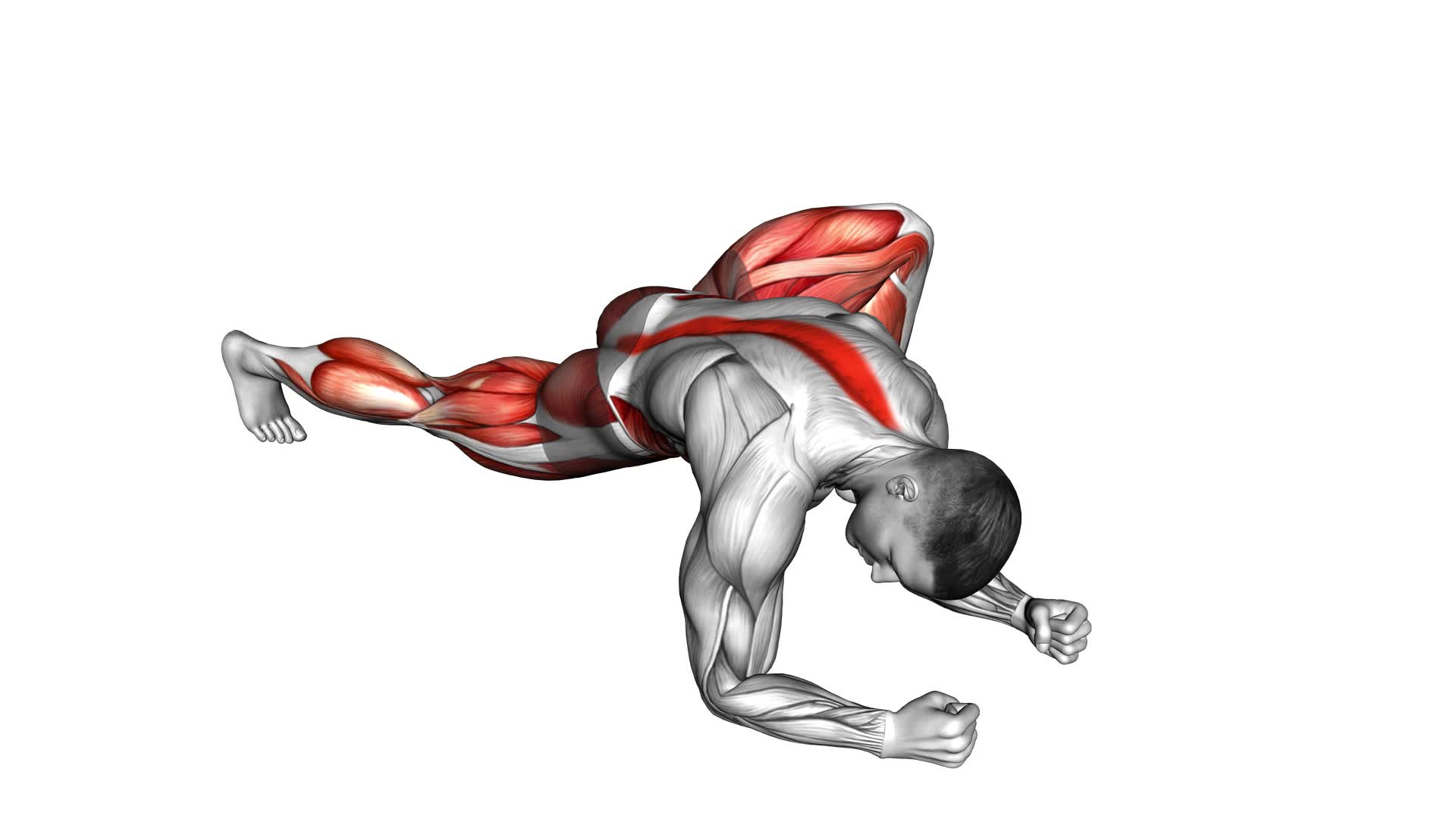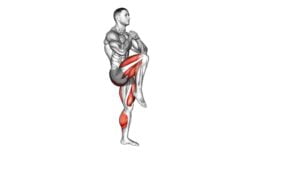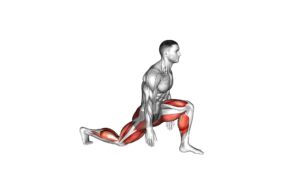Warming-up in Lunge (six) – Video Exercise Guide & Tips

Get ready to warm up your muscles and improve your flexibility with the lunge exercise. In this video exercise guide, we'll show you the proper form and technique for warming up in lunge, along with variations to keep things interesting.
Watch This Exercise Video
Plus, we'll share tips to enhance your lunge warm-up routine. So grab a mat and get ready to lunge your way to a better workout.
Let's get started!
Key Takeaways
- Warming up in lunge increases flexibility and range of motion.
- Proper form and technique for lunge warm-up include stable lunge stance and engaging leg muscles.
- There are variations of lunge warm-up exercises, such as reverse lunge and side lunge, that target different muscle groups.
- Tips to enhance your lunge warm-up routine include focusing on proper form, keeping chest lifted, and aligning the front knee over the ankle.
Benefits of Warming Up in Lunge
To reap the benefits of warming up in lunge, start by positioning yourself in a stable lunge stance. This exercise is highly effective in increasing flexibility and improving balance. By engaging your leg muscles and stretching them in the lunge position, you're able to enhance your range of motion and flexibility. This is particularly beneficial for athletes and individuals involved in activities that require agility and mobility.
Additionally, the lunge warm-up helps to improve your balance by challenging your body to maintain stability in an asymmetrical position. As you lunge forward and backward, your core muscles are engaged to keep you upright, thereby strengthening your balance and stability. Incorporating lunge warm-ups into your exercise routine can have a significant impact on your overall performance and prevent injuries.
Now that you understand the benefits of warming up in lunge, let's move on to discussing proper form and technique for this exercise.
Proper Form and Technique for Lunge Warm-Up
To perform the lunge warm-up properly and effectively, position yourself in a stable lunge stance and engage your leg muscles to enhance flexibility and balance. Start by standing with your feet hip-width apart. Take a step forward with one foot, ensuring that your knee is directly above your ankle when you lower down into the lunge position. Keep your back straight and your core engaged throughout the exercise.
When performing the lunge warm-up, it's important to avoid common mistakes that can lead to injury or ineffective stretching. One common mistake is allowing your front knee to extend beyond your toes, which can put excessive strain on the knee joint. Instead, focus on keeping your knee in line with your ankle.
Another mistake to avoid is leaning too far forward or backward during the lunge. This can compromise your balance and stability. Maintain an upright posture throughout the movement, with your chest lifted and your shoulders relaxed.
Additionally, be mindful of your foot placement. Your front foot should be firmly planted on the ground, with your heel and toes both making contact. Your back foot should be positioned with the heel lifted, allowing for a deeper stretch in the hip flexors.
Variations of Lunge Warm-Up Exercises
In the article 'Warming-up in Lunge (six) – Video Exercise Guide & Tips {346612}', let's explore the various variations of lunge warm-up exercises. Lunge variations can help target different muscles and add variety to your warm-up routine. Here are some lunge variations you can incorporate:
- Reverse Lunge: Instead of stepping forward, step backward with one leg while keeping your front foot planted. This variation engages your hamstrings and glutes more.
- Side Lunge: Take a wide step to the side with one leg, keeping your other leg straight. This variation targets your inner and outer thigh muscles.
- Walking Lunge: Take a step forward with one leg and then bring your back leg forward to meet the front leg. This variation adds a dynamic element to your warm-up routine.
- Curtsy Lunge: Cross one leg behind the other, lowering your body into a lunge position. This variation targets your glutes and outer thighs.
Incorporating these lunge variations into your warm-up routine can help activate different muscle groups and improve your overall flexibility. Now, let's move on to the next section and explore some tips to enhance your lunge warm-up routine.
Tips to Enhance Your Lunge Warm-Up Routine
To enhance your lunge warm-up routine, focus on proper form and alignment. This won't only help you prevent injuries but also enhance flexibility. When performing lunges, make sure to keep your chest lifted, shoulders relaxed, and core engaged.
Align your front knee directly over your ankle and avoid letting it go beyond your toes. Your back knee should be hovering just above the ground, not touching it. Additionally, keep your back straight and avoid leaning forward.
Maintaining proper form is crucial for maximizing the benefits of the lunge warm-up routine and minimizing the risk of injury. By focusing on form and alignment, you can ensure that your muscles are properly engaged and stretched, preparing them for the workout ahead.
Now that you have learned about the tips to enhance your lunge warm-up routine, let's move on to the next section, where we'll provide a sample lunge warm-up video exercise guide.
Sample Lunge Warm-Up Video Exercise Guide
Continue building on your lunge warm-up routine by incorporating a sample lunge warm-up video exercise guide. Watching a video can be a great way to learn new exercises and ensure you're performing them correctly. Here is a sample lunge warm-up video exercise guide that includes dynamic stretching and lunge variations:
- Dynamic Stretching: Start with some dynamic stretching exercises to warm up your muscles and increase your range of motion. Examples include leg swings, walking lunges, and hip circles.
- Forward Lunges: Perform a series of forward lunges, stepping forward with one leg and bending both knees to lower your body. Focus on keeping your front knee aligned with your ankle and your back knee close to the ground.
- Reverse Lunges: Switch to reverse lunges, stepping backward with one leg and bending both knees. Again, keep your front knee aligned with your ankle and your back knee close to the ground.
- Lunge Variations: Mix things up by incorporating lunge variations such as side lunges, curtsy lunges, and jumping lunges. These variations target different muscles and add variety to your warm-up routine.
Remember to listen to your body and adjust the exercises as needed. Use the video as a guide and modify the movements to suit your fitness level and any specific needs or limitations you may have.
Frequently Asked Questions
How Many Sets and Reps Should I Do for the Lunge Warm-Up Exercises?
When it comes to lunge warm-up exercises, the number of sets and reps can vary depending on your fitness level and goals. It's generally recommended to start with 2-3 sets of 10-12 reps per leg. This helps to activate the muscles and increase blood flow, preparing your body for the workout ahead.
Lunge warm-up variations offer benefits like improved mobility, increased strength, and reduced risk of injury. Incorporating these exercises into your routine can greatly enhance your overall performance.
Can I Do Lunge Warm-Up Exercises if I Have Knee or Hip Problems?
If you have knee or hip problems, it's important to find alternative warm-up exercises that won't aggravate your condition. Lunge warm-up exercises may not be suitable for you, but there are modifications you can try.
Consult a professional for specific recommendations tailored to your needs. They can suggest alternative exercises that will help you warm up without putting strain on your knees or hips.
Remember to prioritize your safety and listen to your body's needs.
Is It Necessary to Warm up Before Doing Lunges?
Yes, it's necessary to warm up before doing lunges. Warming up helps prepare your muscles and joints for the movements involved in lunges, reducing the risk of injury.
Dynamic warm up exercises specifically designed for lunges can provide additional benefits, such as increased flexibility and improved range of motion.
It's also important to maintain proper form during lunge warm up exercises to maximize their effectiveness and prevent strain on your knees and hips.
Can I Do Lunge Warm-Up Exercises Every Day?
Yes, you can do lunge warm-up exercises every day to prepare your muscles for the workout.
However, it's important to listen to your body and avoid repetitive strain.
If you start feeling any discomfort or pain, it's advisable to take a break or try alternative exercises that target similar muscle groups.
Remember to always warm up before any exercise to prevent injuries and optimize your performance.
How Long Should I Hold Each Lunge Position During the Warm-Up?
To maximize the benefits of including lunges in your warm-up routine, it's important to know how long to hold each lunge position. The duration may vary depending on your fitness level and flexibility.
Beginners can start with holding each lunge for about 10-15 seconds. As you progress, you can increase the time up to 30 seconds or even longer. This gradual progression will help improve your strength, balance, and flexibility.
Remember to listen to your body and modify the lunges as needed to avoid any discomfort or strain.
Conclusion
In conclusion, warming up in a lunge position offers numerous benefits such as improving flexibility, increasing range of motion, and activating key muscles.
By following proper form and technique, variations of lunge warm-up exercises can be incorporated to target different muscle groups.
To enhance your lunge warm-up routine, focus on maintaining proper alignment, engaging the core, and gradually increasing intensity.
Check out the sample lunge warm-up video exercise guide for a visual demonstration of these exercises.

Author
Years ago, the spark of my life’s passion ignited in my mind the moment I stepped into the local gym for the first time. The inaugural bead of perspiration, the initial endeavor, the very first surge of endorphins, and a sense of pride that washed over me post-workout marked the beginning of my deep-seated interest in strength sports, fitness, and sports nutrition. This very curiosity blossomed rapidly into a profound fascination, propelling me to earn a Master’s degree in Physical Education from the Academy of Physical Education in Krakow, followed by a Sports Manager diploma from the Jagiellonian University. My journey of growth led me to gain more specialized qualifications, such as being a certified personal trainer with a focus on sports dietetics, a lifeguard, and an instructor for wellness and corrective gymnastics. Theoretical knowledge paired seamlessly with practical experience, reinforcing my belief that the transformation of individuals under my guidance was also a reflection of my personal growth. This belief holds true even today. Each day, I strive to push the boundaries and explore new realms. These realms gently elevate me to greater heights. The unique combination of passion for my field and the continuous quest for growth fuels my drive to break new ground.







